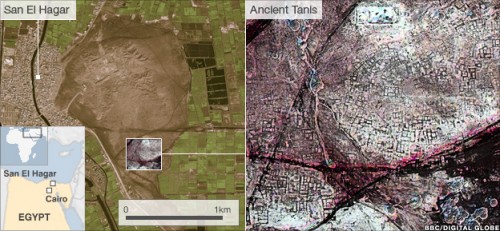
A new satellite survey of Egypt has discovered 17 lost pyramids. The work has been pioneered at the University of Alabama at Birmingham by US Egyptologist Dr Sarah Parcak. The BBC report that more than 1000 tombs and 3000 ancient settlements were also revealed by the infra-red images. The satellites orbited 700km above the earth and were equipped with cameras that are able to pin-point objects less than 1m diameter on the earth’s surface. Following the observations, test excavations took place:
Ancient Egyptians built their houses and structures out of mud brick, which is much denser than the soil that surrounds it, so the shapes of houses, temples and tombs can be seen.
“It just shows us how easy it is to underestimate both the size and scale of past human settlements,” says Dr Parcak.
And she believes there are more antiquities to be discovered:
“These are just the sites [close to] the surface. There are many thousands of additional sites that the Nile has covered over with silt. This is just the beginning of this kind of work.”
- The full article and details of the ‘Egypt’s Lost Cities’ broadcast can be found on the BBC website.








An amazing find – one that is surely going to keep many archaeologists employed for years
And hopefully give us years of fascinating reading about their finds.
It’s truly amazing Cherie, I read about this in the paper this morning; and even more amazing, that in that part of the world where dedicated archeologists are digging ancient building and treasures up, so that we may connect with our forebears, we are busy flattening beautiful buildings and treasures in futile wars, ie Iraq, Bosnia etc!
Evolution perhaps?
Di.x
I think we have gone backwards rather than evolved. We certainly don’t seem to learn our lesson about wars…
I read this on BBC too.
Fascinating article!
I think someone should also invent an infra-red camera that can detect hoards.
So much better than metal detectors! Ha ha…
I think using infra-red to detect hoards would take all the fun out of it
When I read this the other day, Cherie, I dropped my jaw on the floor. Truly amazing.
I imagine the archaeologists will have great fun with that lot